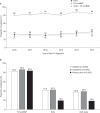Epidemiology of heart failure and trends in diagnostic work-up: a retrospective, population-based cohort study in Sweden
- PMID: 30962724
- PMCID: PMC6435223
- DOI: 10.2147/CLEP.S170873
Epidemiology of heart failure and trends in diagnostic work-up: a retrospective, population-based cohort study in Sweden
Abstract
Purpose: The purpose of this study was to examine the trends in heart failure (HF) epidemiology and diagnostic work-up in Sweden.
Methods: Adults with incident HF (≥2 ICD-10 diagnostic codes) were identified from linked national health registers (cohort 1, 2005-2013) and electronic medical records (cohort 2, 2010-2015; primary/secondary care patients from Uppsala and Västerbotten). Trends in annual HF incidence rate and prevalence, risk of all-cause and cardiovascular disease (CVD)-related 1-year mortality and use of diagnostic tests 6 months before and after first HF diagnosis (cohort 2) were assessed.
Results: Baseline demographic and clinical characteristics were similar for cohort 1 (N=174,537) and 2 (N=8,702), with mean ages of 77.4 and 76.6 years, respectively; almost 30% of patients were aged ≥85 years. From 2010 to 2014, age-adjusted annual incidence rate of HF/1,000 inhabitants decreased (from 3.20 to 2.91, cohort 1; from 4.34 to 3.33, cohort 2), while age-adjusted prevalence increased (from 1.61% to 1.72% and from 2.15% to 2.18%, respectively). Age-adjusted 1-year all-cause and CVD-related mortality was higher in men than in women among patients in cohort 1 (all-cause mortality hazard ratio [HR] men vs women 1.07 [95% CI 1.06-1.09] and CVD-related mortality subdistribution HR for men vs women 1.04 [95% CI 1.02-1.07], respectively). While 83.5% of patients underwent N-terminal pro-B-type natriuretic peptide testing, only 36.4% of patients had an echocardiogram at the time of diagnosis, although this increased overtime. In the national prevalent HF population (patients with a diagnosis in 1997-2004 who survived into the analysis period; N=273,999), death from ischemic heart disease and myocardial infarction declined between 2005 and 2013, while death from HF and atrial fibrillation/flutter increased (P<0.0001 for trends over time).
Conclusion: The annual incidence rate of HF declined over time, while prevalence of HF has increased, suggesting that patients with HF were surviving longer over time. Our study confirms that previously reported epidemiological trends persist and remain to ensure proper diagnostic evaluation and management of patients with HF.
Keywords: diagnosis; heart failure; incidence rate; mortality; prevalence; real-world.
Conflict of interest statement
Disclosure K Lindmark, K Boman, and M Olofsson received lecture grants and consultant fees from Novartis. J Stålhammar received reimbursement from Novartis via IQVIA for performing the study. R Schlienger is an employee of Novartis Pharma AG, Switzerland, and S Bruce Wirta is an employee of Novartis Sweden AB, Sweden. The authors report no other conflicts of interest in this work.
Figures




References
-
- Ponikowski P, Voors AA, Anker SD, et al. ESC guidelines for the diagnosis and treatment of acute and chronic heart failure: the task force for the diagnosis and treatment of acute and chronic heart failure of the European Society of Cardiology (ESC) developed with the special contribution of the Heart Failure Association (HFA) of the ESC. Eur Heart J. 2016;2016(37):2129–2200. - PubMed
-
- Ohlmeier C, Mikolajczyk R, Frick J, Prütz F, Haverkamp W, Garbe E. Incidence, prevalence and 1-year all-cause mortality of heart failure in Germany: a study based on electronic healthcare data of more than six million persons. Clin Res Cardiol. 2015;104(8):688–696. - PubMed
-
- Zarrinkoub R, Wettermark B, Wändell P, et al. The epidemiology of heart failure, based on data for 2.1 million inhabitants in Sweden. Eur J Heart Fail. 2013;15(9):995–1002. - PubMed
LinkOut - more resources
Full Text Sources
Research Materials
Miscellaneous

